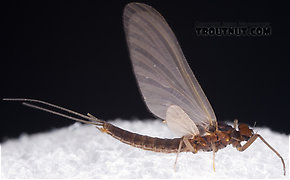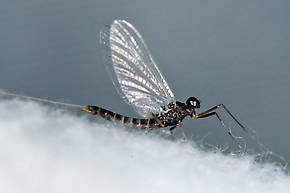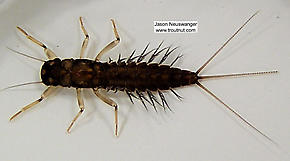Blog & Latest Updates
Fly Fishing Articles
Insects by Common Name


Blue Quills
Scientific Names
Like most common names, "Blue Quill" can refer to more than one taxon. They're previewed below, along with 11 specimens. For more detail click through to the scientific names.
Mayfly Species Neoleptophlebia adoptiva
These are pretty much always called Blue Quills.
This is the best Spring hatch after the Quill Gordons (Epeorus pleuralis) but before the Hendricksons (Ephemerella subvaria) in most parts of the East, although it can overlap with both. The Blue Quills are small mayflies (hook size 16-20) but they can hatch in incredible numbers at a time when eager trout are just beginning to look to the surface after a hungry winter.
Male Neoleptophlebia adoptiva (Blue Quill) Mayfly Spinner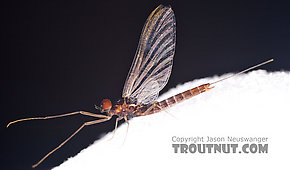 View 7 PicturesBased on the pale longitudinal forewing veins (excepting the costals), dark middle terga (Tergum: the dorsal part of an abdominal segment or segments (terga). Also used to describe the entire abdominal dorsum or the thoracic dorsal segments of Odonata.), and genitalia (Burks '53), this specimen is P. adoptiva.
View 7 PicturesBased on the pale longitudinal forewing veins (excepting the costals), dark middle terga (Tergum: the dorsal part of an abdominal segment or segments (terga). Also used to describe the entire abdominal dorsum or the thoracic dorsal segments of Odonata.), and genitalia (Burks '53), this specimen is P. adoptiva.
 View 7 PicturesBased on the pale longitudinal forewing veins (excepting the costals), dark middle terga (Tergum: the dorsal part of an abdominal segment or segments (terga). Also used to describe the entire abdominal dorsum or the thoracic dorsal segments of Odonata.), and genitalia (Burks '53), this specimen is P. adoptiva.
View 7 PicturesBased on the pale longitudinal forewing veins (excepting the costals), dark middle terga (Tergum: the dorsal part of an abdominal segment or segments (terga). Also used to describe the entire abdominal dorsum or the thoracic dorsal segments of Odonata.), and genitalia (Burks '53), this specimen is P. adoptiva.Mayfly Species Paraleptophlebia gregalis
These are pretty much always called Blue Quills.
This species produces fishable hatches, but it is not well-known in angling literature. This is due primarily to its range, which consists only of California and parts of Oregon. It is a small (by western Paraleptophlebia standards) Spring emerger that fills the niche taken by Paraleptophlebia heteronea in the rest of the West.
Mayfly Species Neoleptophlebia heteronea
These are pretty much always called Blue Quills.
This species is the primary spring emerging Paraleptophlebia throughout the western region. Outside of California and parts of Oregon, if you run into a little blue winged brown bodied fly with three tails in the spring, it's probably this.
Male Neoleptophlebia heteronea (Blue Quill) Mayfly Spinner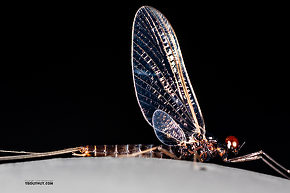 View 12 PicturesI keyed this one out to species on the microscope because it was too small for the genitalia to show the distinguishing characteristics in the images here.
View 12 PicturesI keyed this one out to species on the microscope because it was too small for the genitalia to show the distinguishing characteristics in the images here.
 View 12 PicturesI keyed this one out to species on the microscope because it was too small for the genitalia to show the distinguishing characteristics in the images here.
View 12 PicturesI keyed this one out to species on the microscope because it was too small for the genitalia to show the distinguishing characteristics in the images here.See 3 more specimens...
Mayfly Genus Paraleptophlebia
These are often called Blue Quills.
There are many species in this genus of mayflies, and some of them produce excellent hatches. Commonly known as Blue Quills or Mahogany Duns, they include some of the first mayflies to hatch in the Spring and some of the last to finish in the Fall.
In the East and Midwest, their small size (16 to 20, but mostly 18's) makes them difficult to match with old techniques. In the 1950s Ernest Schwiebert wrote in Matching the Hatch:
Fortunately, modern anglers with experience fishing hatches of tiny Baetis and Tricorythodes mayflies are better prepared for eastern Paraleptophlebia. It's hard to make sense of so many species, but only one is very important and others can be considered in groups because they often hatch together:
In the East and Midwest, their small size (16 to 20, but mostly 18's) makes them difficult to match with old techniques. In the 1950s Ernest Schwiebert wrote in Matching the Hatch:
"The Paraleptophlebia hatches are the seasonal Waterloo of most anglers, for without fine tippets and tiny flies an empty basket is assured."
Fortunately, modern anglers with experience fishing hatches of tiny Baetis and Tricorythodes mayflies are better prepared for eastern Paraleptophlebia. It's hard to make sense of so many species, but only one is very important and others can be considered in groups because they often hatch together:
- Paraleptophlebia adoptiva is by far the most important species of this genus in the two regions and is an early Spring emerger.
- Paraleptophlebia mollis, Paraleptophlebia guttata, and Paraleptophlebia strigula complement each other in late spring and early summer.
- Paraleptophlebia debilis and Paraleptophlebia praepedita occur together in the fall.
- The most important species is Paraleptophlebia debilis. This large (for the genus) Fall emerger can be found throughout the region. It is often accompanied by one of the slightly larger tusked species. Depending on locale, this can be Paraleptophlebia bicornuta (the most common), Paraleptophlebia packii or Paraleptophlebia helena. Check out their hatch pages for distribution information.
- Spring is the season for the smaller Paraleptophlebia heteronea throughout most of the region with Paraleptophlebia gregalis filling this niche in California and parts of Oregon.
Female Paraleptophlebia (Blue Quills and Mahogany Duns) Mayfly Dun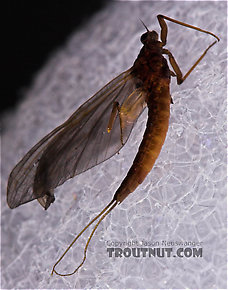 View 4 PicturesI really hoped to catch some good blue quill specimens on this trip, but they are very fragile mayflies and this one was in the best condition of the few that I caught after I drove them home to my camera. It may not be pretty, but you get an idea of the size/shape/color anyway.
View 4 PicturesI really hoped to catch some good blue quill specimens on this trip, but they are very fragile mayflies and this one was in the best condition of the few that I caught after I drove them home to my camera. It may not be pretty, but you get an idea of the size/shape/color anyway.
 View 4 PicturesI really hoped to catch some good blue quill specimens on this trip, but they are very fragile mayflies and this one was in the best condition of the few that I caught after I drove them home to my camera. It may not be pretty, but you get an idea of the size/shape/color anyway.
View 4 PicturesI really hoped to catch some good blue quill specimens on this trip, but they are very fragile mayflies and this one was in the best condition of the few that I caught after I drove them home to my camera. It may not be pretty, but you get an idea of the size/shape/color anyway.Male Paraleptophlebia (Blue Quills and Mahogany Duns) Mayfly Spinner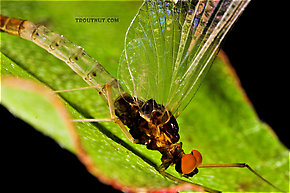 View 15 PicturesI wasn't actually fishing the river where I caught this one. I was just scouting, didn't like the look of the water, and as I was walking back to the car this little dun landed on my vest. Why can't they all be so easy to collect?
View 15 PicturesI wasn't actually fishing the river where I caught this one. I was just scouting, didn't like the look of the water, and as I was walking back to the car this little dun landed on my vest. Why can't they all be so easy to collect?
 View 15 PicturesI wasn't actually fishing the river where I caught this one. I was just scouting, didn't like the look of the water, and as I was walking back to the car this little dun landed on my vest. Why can't they all be so easy to collect?
View 15 PicturesI wasn't actually fishing the river where I caught this one. I was just scouting, didn't like the look of the water, and as I was walking back to the car this little dun landed on my vest. Why can't they all be so easy to collect?Female Paraleptophlebia (Blue Quills and Mahogany Duns) Mayfly Adult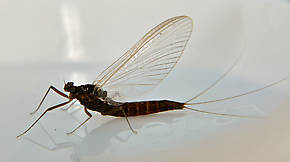 View 1 PicturesThis female exhibits the dark chocolate color so common in this genus.
View 1 PicturesThis female exhibits the dark chocolate color so common in this genus.
 View 1 PicturesThis female exhibits the dark chocolate color so common in this genus.
View 1 PicturesThis female exhibits the dark chocolate color so common in this genus.See 26 more specimens...
Mayfly Species Paraleptophlebia guttata
These are often called Blue Quills.
This species often hatches together with Paraleptophlebia mollis and Paraleptophlebia strigula.
Mayfly Species Paraleptophlebia strigula
These are often called Blue Quills.
This species often hatches together with Paraleptophlebia mollis and Paraleptophlebia guttata.
Mayfly Species Leptophlebia johnsoni
These are very rarely called Blue Quills.
Mayfly Species Epeorus pleuralis
These are very rarely called Blue Quills.
This is the first really good dry-fly opportunity of the season for most Eastern anglers. They are large mayflies and they have good points of vulnerability both underwater and on the surface.
Epeorus pleuralis (Quill Gordon) Mayfly Nymph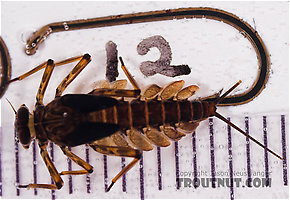 View 4 PicturesThis Epeorus pluralis dun is recently deceased in these photos. I decided not to photograph several lively, less mature nymphs. This one was ready to hatch, as indicated by the black wing pads (
View 4 PicturesThis Epeorus pluralis dun is recently deceased in these photos. I decided not to photograph several lively, less mature nymphs. This one was ready to hatch, as indicated by the black wing pads (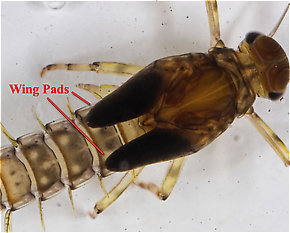 Wing pad: A protrusion from the thorax of an insect nymph which holds the developing wings. Black wing pads usually indicate that the nymph is nearly ready to emerge into an adult.). I believe it had not been dead long enough to lose its natural coloration.
Wing pad: A protrusion from the thorax of an insect nymph which holds the developing wings. Black wing pads usually indicate that the nymph is nearly ready to emerge into an adult.). I believe it had not been dead long enough to lose its natural coloration.
 View 4 PicturesThis Epeorus pluralis dun is recently deceased in these photos. I decided not to photograph several lively, less mature nymphs. This one was ready to hatch, as indicated by the black wing pads (
View 4 PicturesThis Epeorus pluralis dun is recently deceased in these photos. I decided not to photograph several lively, less mature nymphs. This one was ready to hatch, as indicated by the black wing pads (
The wing pads on this final instar Baetidae mayfly nymph are extremely dark.
Male Epeorus pleuralis (Quill Gordon) Mayfly Dun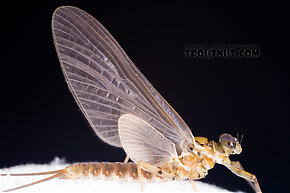 View 9 PicturesI kept this specimen after photographing it and it molted into a spinner in perfect condition, which I photographed here.
View 9 PicturesI kept this specimen after photographing it and it molted into a spinner in perfect condition, which I photographed here.
 View 9 PicturesI kept this specimen after photographing it and it molted into a spinner in perfect condition, which I photographed here.
View 9 PicturesI kept this specimen after photographing it and it molted into a spinner in perfect condition, which I photographed here.Male Epeorus pleuralis (Quill Gordon) Mayfly Spinner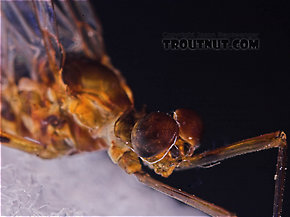 View 10 PicturesI spent (Spent: The wing position of many aquatic insects when they fall on the water after mating. The wings of both sides lay flat on the water. The word may be used to describe insects with their wings in that position, as well as the position itself.) most of the day looking for Epeorus pluralis duns or spinners without any luck on the major Catskill rivers. Finally in the evening I arrived at a small stream somebody had recommended, and when I got out of the car I was happy to find that I had parked in the middle of a cloud of male spinners.
View 10 PicturesI spent (Spent: The wing position of many aquatic insects when they fall on the water after mating. The wings of both sides lay flat on the water. The word may be used to describe insects with their wings in that position, as well as the position itself.) most of the day looking for Epeorus pluralis duns or spinners without any luck on the major Catskill rivers. Finally in the evening I arrived at a small stream somebody had recommended, and when I got out of the car I was happy to find that I had parked in the middle of a cloud of male spinners.
 View 10 PicturesI spent (Spent: The wing position of many aquatic insects when they fall on the water after mating. The wings of both sides lay flat on the water. The word may be used to describe insects with their wings in that position, as well as the position itself.) most of the day looking for Epeorus pluralis duns or spinners without any luck on the major Catskill rivers. Finally in the evening I arrived at a small stream somebody had recommended, and when I got out of the car I was happy to find that I had parked in the middle of a cloud of male spinners.
View 10 PicturesI spent (Spent: The wing position of many aquatic insects when they fall on the water after mating. The wings of both sides lay flat on the water. The word may be used to describe insects with their wings in that position, as well as the position itself.) most of the day looking for Epeorus pluralis duns or spinners without any luck on the major Catskill rivers. Finally in the evening I arrived at a small stream somebody had recommended, and when I got out of the car I was happy to find that I had parked in the middle of a cloud of male spinners.See 2 more specimens...
Top 10 Fly Hatches
Top Gift Shop Designs
Eat mayflies.
Top Insect Specimens
Miscellaneous Sites
Troutnut.com is copyright © 2004-2024 Jason
Neuswanger (email Jason). See my FAQ for information about use of my images.
 privacy policy
privacy policy

